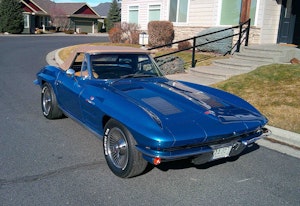Media | Articles
Our 3 big takeaways from the 2020 Arizona Auctions
The Arizona Auctions have long been a barometer for how the enthusiast car market is performing. Informed observers were not unanimous in their opinions this year, but the general consensus was that results indicated the market isn’t in the middle of a pressure drop. Over the course of ten days, eight auction companies offered 3867 vehicles for sale, with 2994 of them actually moving. The $244.1M overall sales total was down $7M from a year ago but outpaced Hagerty’s forecast by 5 percent. While there are plenty of doomsday cautionaries, the results are nevertheless reassuring if the last time you performed a health check in the collector car market was in the wake of the lackluster Monterey auctions.
A big reason for the decent showing was Leake Auction’s premiere appearance in the Valley of the Sun; the Ritchie Brothers-owned company ran a whopping 674 cars across the block, exercising an age-old strategy of throwing volume against sliding prices to maintain ground. Shuffling along hundreds of cheaper cars can help hide missteps among million-dollar lots when looking at top-level results.
Another reason for the mild success was the auction companies’ ability to reset sellers’ expectations. Consignors who are shooting for the moon now have fewer auction houses willing to make room. In the current climate it is better for all to turn a car down if it carries an unrealistic estimate than to rack up a high-profile no-sale (or five) that will ultimately stick with the car after the auction and drag down an entire sale.
More lessons abound—here are three big takeaways we found after digging through the numbers.
The top of the market is as selective as ever
Marketplace
Buy and sell classics with confidence

Buyers in a position to cut a seven-figure check have no interest in taking on unnecessary risk. As speculators have left for more greener opportunities, the paddle-wavers remaining at this level are knowledgeable, demanding, and patient, which is putting pressure on sellers. Unless a car was perfectly presented, fresh to market, or exceptional in its history, there were very few takers last week. Expensive cars with stories or needs were summarily dismissed, as there is little upside and less motivation in the current climate for such examples.
To wit, a 1969 Lamborghini Miura P400 S offered by Bonhams was due for a full and costly restoration. Earlier this decade, enough buyers would have justified the impending expense through future gains to drive the price up. Today’s shoppers aren’t willing to bank on that payback anymore and therefore have hard ceilings on what they are willing to spend for such a car. In this case, the Miura was a no-sale at $800,000.
While this trend has been forming for a year, the monetary threshold slipped even lower in January and $250,000 now seems to be the level at which extreme caution sets in.
Affordable, enthusiast-oriented cars are booming

While a bidding war for a big-ticket item requires perfection, there is less to lose when shopping downmarket. A $200,000 car losing 10 percent of its value over some window of time is much more noticeable than a $20,000 car experiencing a similar decline, which is why cars that were priced around $25,000 did well in Arizona.
Other reasons include the continued strength of the economy, a pent-up demand from folks who have grown weary of waiting for a better read of the market, and a wealth of interesting options at this budget across a variety of tastes. Vintage trucks and SUVs in particular continue to benefit from this obsession of affordability (along with other factors). A frame-off rebuilt 1983 Toyota SR5 pickup sold for $31,350, or more than $13,000 above the condition-#1 (Concours) Hagerty Price Guide value.
Condition is king


As mentioned in lesson one above, expensive cars with needs were passed over time and again. Those cars that were in exceptional condition, however, grabbed the gold ring. Instant gratification is a big part of this, as well as wide recognition that collectors are seeking out the best examples with the lowest miles in the most desirable spec. When those chances arise, a bidding war ensues.
A clear example of this was seen at Barrett-Jackson, when a world record for a Mk III Toyota Supra was broken on two consecutive days. The first record fell when a 1987 model with 177 miles sold for $71,500. It was topped a day later when a 91-mile 1990 Mk III Supra, still in the wrapper, sold for $88,000. The two other Mk IIIs offered by Barrett-Jackson were in average condition and sold for $16,500 and $14,300, illustrating the delta between “exceptional” and “something less than.”
Barring any “black swan” events, we expect these trends to continue in the coming months and be apparent at the Paris and Amelia Island auctions over the next six weeks. With the current climate favoring buyers, those with long-term intentions who are performing their due diligence can find plenty of opportunities.
Like this article? Check out Hagerty Insider, our e-magazine devoted to tracking trends in the collector car market.
























